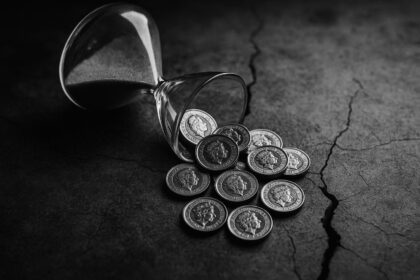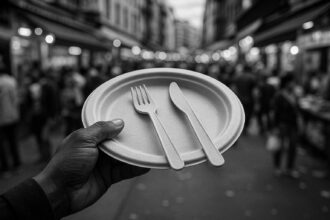Since 2015, the Too Good To Go app has rescued over 400 million meals and gained more than 100 million users worldwide, sparking a TikTok trend as shoppers revel in ‘mystery bags’ of surplus food while raising awareness about the urgent cost of food waste.
A woman sits in her kitchen, excitedly showcasing the contents of a mystery bag she picked up through the app Too Good To Go, as if she has scored a rare designer piece. Her haul, consisting of items from Pret a Manger—such as porridge, croissants, and a savoury breakfast dish—brings her palpable joy. This excitement, which has become a cultural phenomenon echoed by countless TikTok users, exemplifies a larger movement surrounding food waste and conscious consumerism.
Since its launch in Copenhagen in 2015, Too Good To Go has been dedicated to combating food waste, a critical issue given that one-third of the planet’s food production is wasted each year. This waste adds up, costing countries like the UK approximately £22 billion annually. In the decade since its inception, Too Good To Go has gathered over 100 million registered users and enabled the rescue of more than 400 million meals through partnerships with around 175,000 retailers worldwide.
Sophie Trueman, the company’s UK and Ireland director, emphasises the app’s mission to mitigate food waste, stating, “We believe that we cannot afford to waste food. It’s too valuable – for the planet, for society and for the economy.” Such sentiments underline the urgent need for scalable solutions that can make a tangible impact over time.
The app has gained significant traction in the UK, with users simply purchasing a mystery bag and collecting it within specified times. The appeal lies not only in the practical benefits of reducing food waste and saving money but also the thrill of obtaining unexpected food items. From fresh pasta to a loaf of artisan bread, many users, myself included, eagerly check the app to see what’s available at supermarkets and independent shops alike.
Yet, this excitement has led to a burgeoning subculture, with social media platforms flooded by ‘what’s in my bag’ videos. Creators like Rackie from Berkshire showcase their discoveries, bridging the gap between monetary savings and an environmental mission. However, she points out a paradox; while the aim is to curb food waste, some users may treat it more as a fun trend, compromising the app’s core message.
The dynamics shift when considering the psychological aspects of the app. Users set alarms to snag desirable mystery bags quickly, sometimes transporting surplus food across town. This has raised concerns about the potential for the original aim of reducing waste becoming secondary to the allure of acquiring food. Comments echoing that users have “forgotten what Too Good To Go is” resonate with the growing sentiment that its social media representation may detract from its initial purpose.
Too Good To Go is acutely aware of these challenges and remains vigilant in promoting their environmental messaging. As Trueman asserts, every meal saved contributes to a larger communal effort against food waste. Users can track the carbon emissions avoided by saving meals, thereby reinforcing the notion that individual actions can aggregate to significant change.
Despite the enthusiasm, the app is not without its complications. Consumer preferences and dietary restrictions often challenge the mystery bag model. The unpredictability in bag contents means users may occasionally receive items they cannot eat, leading to further waste. For instance, one viral TikTok showcased a user’s dismay at receiving an egg mayo sandwich—an item they deemed unfit for consumption.
Discussions surrounding food waste aren’t merely about individual item discrepancies; they also highlight systemic issues within food distribution networks. Zoe Adjey, Senior Lecturer in Hospitality at the University of East London, notes that businesses frequently fear the ramifications of giving away surplus food due to liability concerns and food safety regulations. “The legal and reputational consequences of food-borne illness create a strong incentive for businesses to err on the side of caution when disposing of surplus food,” she explains.
Yet, despite these hurdles, Too Good To Go has transformed perceptions of food waste from a stigmatised issue to a mainstream solution for saving money and fostering environmental consciousness. Not only does the app help cut down on waste, but it also encourages social engagement around food security and sustainability, progressively reshaping how consumers perceive surplus food.
Ultimately, the surge of users engaging with the app reveals a collective desire to tackle food waste while saving money. While some may indulge in the thrill of ‘mystery bags’, the overarching goal remains significant. As Rackie articulates, “If the ultimate result is that food doesn’t get wasted, then that’s a good thing, however you get to that point.” This perspective underscores that the journey towards sustainability, albeit imperfect, can lead to tangible benefits for both consumers and the environment.
Reference Map:
- Paragraph 1 – [1], [2]
- Paragraph 2 – [1], [3], [4]
- Paragraph 3 – [2], [5], [6]
- Paragraph 4 – [1], [6]
- Paragraph 5 – [1], [3]
- Paragraph 6 – [4], [7]
- Paragraph 7 – [1], [5]
- Paragraph 8 – [3], [4]
- Paragraph 9 – [6], [7]
- Paragraph 10 – [1], [3]
- Paragraph 11 – [1], [3]
Source: Noah Wire Services
- https://www.independent.co.uk/life-style/food-waste-apps-too-good-to-go-b2760717.html – Please view link – unable to able to access data
- https://www.toogoodtogo.com/en – Too Good To Go is a mobile application founded in Copenhagen in 2015 that connects consumers with local restaurants and stores to purchase surplus unsold food at discounted prices, aiming to reduce food waste globally. As of 2023, the app has saved over 200 million meals and operates in multiple countries, including the UK, Europe, North America, and Australia. Users can browse for ‘surprise bags’ of food, reserve and pay through the app, and pick up their food at scheduled times without the hassle of in-store transactions.
- https://www.toogoodtogo.com/press/impact-report-2022 – In its 2022 Impact Report, Too Good To Go announced significant progress in combating food waste, reporting a 50% increase in meals saved compared to the previous year. The report highlighted the acquisition of CodaBene, the launch of Magic Parcels to rescue food from the manufacturing stage, and the date labelling initiative aiming to reduce food waste at the household level. In 2022, the company saved over 79 million meals from going to waste, equivalent to avoiding emissions similar to flying 500,000 passengers from London to Berlin.
- https://www.uncommonfood.com/too-good-to-go-revolutionizing-the-fight-against-food-waste/ – Too Good To Go has revolutionised the fight against food waste by connecting consumers with local businesses to purchase surplus food at discounted prices. As of 2024, the app has saved over 350 million meals, preventing more than 873,500 tons of CO2 emissions. With over 100 million registered users and collaborations with more than 170,000 businesses globally, the app has expanded its reach to Europe, North America, and Australia, partnering with well-known chains like Starbucks and Carrefour.
- https://www.axios.com/local/salt-lake-city/2025/05/27/too-good-to-go-salt-lake-expansion – Too Good To Go has expanded its services to Salt Lake City, Utah, aiming to reduce food waste through affordable grocery options. The app connects consumers with local restaurants, bakeries, and grocery stores offering surplus food at deeply discounted prices, typically half or even a third of the original retail cost. This initiative addresses the growing issue of food insecurity and the staggering statistic that approximately one-third of all food in the U.S. is discarded, according to the USDA.
- https://www.axios.com/local/pittsburgh/2025/05/21/food-waste-app-too-good-to-go – Too Good To Go launched in Pittsburgh on May 21, 2025, marking a significant step in combating food waste in the region. The app enables consumers to purchase surplus fresh food from restaurants and retailers at reduced prices, typically half or one-third of the retail value. Around 50 local businesses in Pittsburgh have joined the platform, including major retailers like Whole Foods and local stores such as Macaron Bar and Bagel Factory, aiming to reduce waste and offer affordable meals to consumers.
- https://www.axios.com/local/columbus/2024/08/27/discounted-surplus-food-new-app-ohio – Too Good To Go, an app designed to reduce food waste and save money, has launched in Columbus, Ohio. The app allows local businesses to sell their surplus food at discounted rates rather than discarding it. Since its local debut on August 14, numerous restaurants like Borgata Pizza Cafe and Lion Cub’s Cookies are participating. However, the high demand makes snagging a bag challenging, and pickup times can be inconvenient. Users can share their experiences and tips on the Too Good To Go subreddit.













